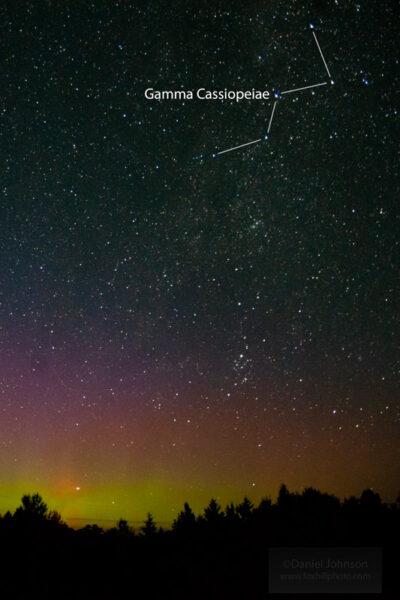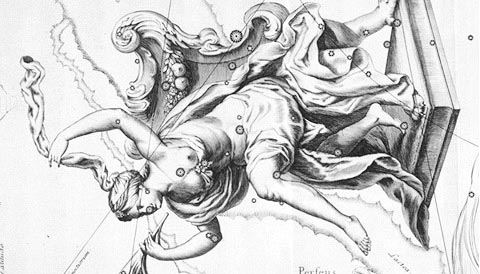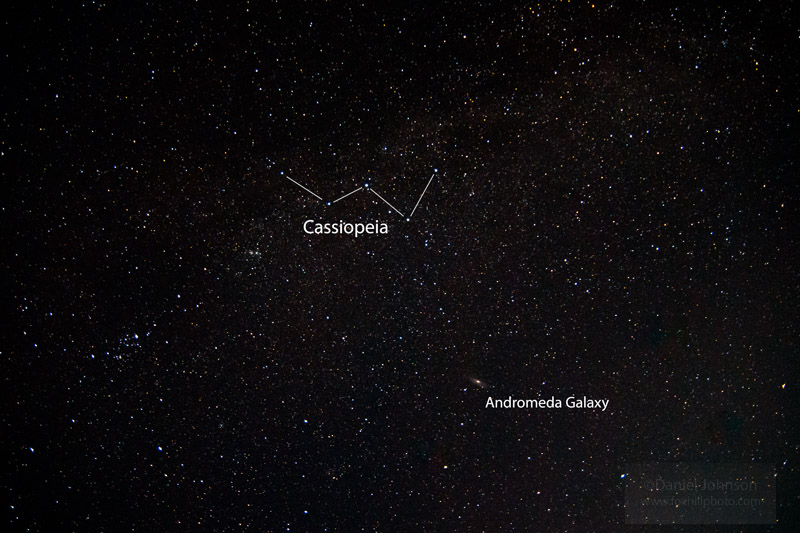Gamma Cassiopeiae Vitals
| Common name | Gamma Cassiopeiae |
| Other designations | HIP 4427, HR 264, HD 5394 |
| Nicknames | Navi, Tsih (the Whip) in old China |
| Apparent magnitude | Varies; currently about 2.15 (historically 1.6–3.0) |
| Distance from Earth | 613 light-years |
| Type | B0.5IVpe |
| Color | Blue |
| Mass | 17 M☉ |
| Radius | 10 R☉ |
| Constellation | Cassiopeia |
| Right Ascension | 0h 56m 42s |
| Declination | 60° 43' 00” |
| Multiple system? | Yes |
| Variable star? | Yes |
| Exoplanet status | None known |
| Probable fate | Supernova |
Physical Characteristics
A variable star is a star that fluctuates in brightness over a period of time, perhaps less than a day, or maybe weeks, months, or years. Variable stars are a large class of objects that amateur and professional astronomers have long chased for both fun and science. Even the Sun is slightly variable, brightening and dimming over a roughly 11-year period by 0.1%. Other stars are more dramatic, including a class of irregularly changing stars known as eruptive variables.

Daniel Johnson
If you’d like to seek out one of these for yourself, there’s a bright and easy-to-find eruptive variable in the northern sky — and you’ve probably seen it many times without knowing it. That star is Gamma Cassiopeiae, the middle point in the W shape of Cassiopeia. Sometimes Gamma Cassiopeiae dims to 3rd-magnitude, while during other periods it shines as brightly as magnitude 1.6, as it did in the 1930s. But those changes aren’t predictable, so what’s going on?
Gamma Cassiopeiae rotates at a high speed — so fast that its shape is distorted, similar to the effects seen on Vega, Regulus, and Altair. But Gamma Cassiopeiae spins much faster, some 400 kilometers per second (900,000 mph), and the resulting colossal forces are strong enough to occasionally dislodge matter from the star. This material then forms a disk of orbiting material. While distance prevents us from directly observing the disk, we can nevertheless determine its existence through spectroscopy. The star’s brightness changes as matter is flung from the star — hence the name eruptive variable.
Gamma Cassiopeiae is classified as a Be star, different from ordinary B-class stars. The lowercase e stands for emission lines from hydrogen, first noted by Father Angelo Secchi in the 19th century. These lines come from the ejected gases.
Origin / Mythology
In Greek myths, Queen Cassiopeia was the rather vain mother of Andromeda, and some star map illustrations portray the constellation as the queen seated in a W-shape chair, looking at herself in a mirror. In some Chinese mythology, the W is incorporated in a chariot driver constellation, with Gamma Cassiopeiae representing the whip (“Tsih” in Chinese).

Source: Johannes Hevelius
However, there is little existing mythology involving the star Gamma Cassiopeiae specifically, and the star oddly lacks a traditional Greek or Arabic name, and doesn’t have a proper name at all. The Gamma Cassiopeiae label we use today is strictly utilitarian, part of Johann Bayer’s star-cataloging efforts of the 1600s.
Occasionally, though, Gamma Cassiopeiae is referred to informally as “Navi.” This recent nickname came out of the Apollo Program of the 1960/70s. Gamma Cassiopeiae was one of the many stars used as to calibrate the gyroscopes aboard Apollo spacecraft. Noticing that the star lacked a traditional name, astronaut Gus Ivan Grissom playfully labeled Gamma Cassiopeiae “Navi” on his star chart — using his own middle name spelled backwards. Later Apollo astronauts continued the tradition, and Navi has since found its way into general use in some instances — such as in the popular astronomy software Stellarium.
How to See Gamma Cassiopeiae
Gamma Cassiopeiae is easy to find from the U.S. From about 35°N latitude, the star is circumpolar and never drops below the horizon. Cassiopeia is probably one of the most recognizable constellations in the northern sky. The familiar W shape is easy to remember, and Cassiopeia rotates around Polaris roughly opposite the Big Dipper.

Cassiopeia sits right in the middle of the Milky Way band, so it’s worth trying to find a dark sky away from artificial lights for viewing, so that you can see the full effect of the constellation backlit by the edge of our galaxy. While you’re there, use the larger point of Cassiopeia’s lopsided W to take a quick hop over to a different galaxy altogether: the majestic Andromeda. (Remember, the Andromeda Galaxy is of course in the constellation Andromeda, and Andromeda is Cassiopeia’s daughter, so they’re next to each other in the sky — makes sense, right?)
Observing Gamma Cassiopeia is also a nice way to investigate the interstellar medium. We tend to think of space as completely empty, but there are plenty of gas and dust particles drifting about, particularly in line with the edge of our galaxy. Gamma Cassiopeiae would actually shine about 0.35 magnitudes brighter if it were in another section of the sky, but its location in line with the plane of the Milky Way places it in a rather dusty region. When you point your telescope at Gamma Cassiopeiae, you’re not only looking at a distant star, you’re looking through untold numbers of space dust particles slowly rotating around the center of our galaxy.
While you observe Gamma Cassiopeiae, try to visualize the immense activity taking place there and in between — and at the same time, be thankful for the relative tranquility of our own Sun.
Daniel Johnson is a Wisconsin-based freelance writer and professional photographer and the co-author of over a dozen books. He’s a longtime amateur astronomer and fortunate enough to live in a rural region with excellent seeing conditions. You can view some of Dan’s photography (he does a lot of animals!) at www.foxhillphoto.com
 4
4
Comments
Anthony Barreiro
August 31, 2021 at 4:27 pm
Another cool thing about Gamma Cassiopeiae -- you can use it to find the north star. Beta, Gamma, and Delta Cas are roughly in a straight line in the sky. If you start at Gamma and draw a perpendicular line away from Cassiopeia, the first moderately bright star you get to will be the north star. Because Cassiopeia and the Big Dipper are on opposite sides of the north star, when one is down toward the horizon the other is high in the sky, so when the sky is clear you should always be able to find at least one of them.
You must be logged in to post a comment.
Daniel_Johnson
August 31, 2021 at 4:47 pm
Thanks for that, I hadn't heard that before. Interesting!
You must be logged in to post a comment.
Andrew James
August 31, 2021 at 7:51 pm
Yes. It is more known irregular variable but is also a wide triple. S.W. Burnham found the first Gamma Cas distant 12.9v mag. companion in 1878, now catalogued as BU 499AC. ‘C’ presently lies 53.4 arcsec in PA 346 deg (2009), being likely just a field star that seems to be continuing to slowly widen. Duplicity of BU 1028AB was discovered by Burnham in 1888, being a very unequal pair of 2.2v/10.9v mag., whose separation is 2.1 arcsec in PA 259 deg (2002). This brightness difference is very problematic, making resolution difficult to impossible for smallish apertures and quite testing for moderate ones.
Tezlaff et al. (2011) found for Gamma Vas A with Mass=19.3±0.1 solar mass and age is 8.0±0.4 million years. B0IV:e var in earlier sources.
Hope this is of interest.
You must be logged in to post a comment.
James Rogers
September 3, 2021 at 7:59 pm
Thanks for the interesting article Daniel, but I'm not clear about when the star's brightness increases. Does Gamma Cassiopeia become brighter when it erupts? Or does the ejected material that forms the disc make the star become dimmer? Thanks again.
You must be logged in to post a comment.
You must be logged in to post a comment.